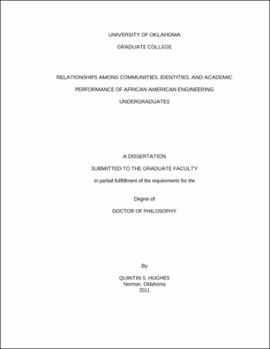| dc.contributor.advisor | Shehab, Randa L||Walden, Susan E | |
| dc.creator | Hughes, Quintin S | |
| dc.date.accessioned | 2019-04-27T21:30:37Z | |
| dc.date.available | 2019-04-27T21:30:37Z | |
| dc.date.issued | 2011 | |
| dc.identifier | 99255107402042 | |
| dc.identifier.uri | https://hdl.handle.net/11244/318869 | |
| dc.description.abstract | A potential barrier to increasing diversity in engineering may be the failure of engineering colleges within predominantly White institutions (PWI's) to understand, acknowledge, and/or accommodate the unique perspectives of its under-represented minority students. Numerous studies have shown us that the success of many under-represented minority students at PWI's may be impacted by lack of community, feelings of isolation from their culture, and disidentification within their field (Foor, Walden, & Trytten, 2007; Seymour & Hewitt, 1997; Shehab et al., 2007; Shehab, Murphy, & Foor, 2011; Walden & Shehab, 2009). | |
| dc.description.abstract | This study represents a phenomenological analysis of data collected by the Research Institute for STEM Education (RISE), who conducted a study seeking to identify factors contributing to the success of under-represented and under-served minority engineering students at a predominantly White research institution. Minority undergraduate engineering students participated in face-to-face interviews designed to engage them in reflection and discussion of their experiences as engineering students. The interview data for 19 successful African American undergraduate engineering students were selected from three academic performance groups: excellers, persisters, and strugglers. Their interview data were analyzed to address the question of how community and identity contribute to the academic achievement of successful African American engineering undergraduates of a predominantly White institution. | |
| dc.description.abstract | To answer this question, student experiential narratives were interpreted through the lenses of community, Black identity, and engineering identity to better understand how these constructs influence the student academic performances. Results suggest that community, Black identity, engineering identity, and academic performance may moderate each other. Students found community in different places based on their academic grouping. Excellers found community in a wider range of places and were most likely to find community in engineering organizations with majority White membership. Persisters and strugglers were more limited in the places they found community and mostly participated in more ethnocentric organizations. Persisters and Strugglers were more reliant on Black reference groups for community than were excellers, indicating stronger reliance on same race communities. Engineering discursive identity increased as academic performance increased. Surprisingly, several students from each grouping held negative images of engineers which often clashed with their own identities, perhaps suggesting a potential friction between Black and Engineering identities. | |
| dc.format.extent | 116 pages | |
| dc.format.medium | application.pdf | |
| dc.language | en_US | |
| dc.relation.requires | Adobe Acrobat Reader | |
| dc.subject | African American engineers | |
| dc.subject | African American students | |
| dc.subject | Multicultural education | |
| dc.subject | Engineering--Education | |
| dc.title | RELATIONSHIPS AMONG COMMUNITIES, IDENTITIES, AND ACADEMIC PERFORMANCE OF AFRICAN AMERICAN ENGINEERING UNDERGRADUATES | |
| dc.type | text | |
| dc.type | document | |
| dc.thesis.degree | Ph.D. | |
| ou.group | College of Engineering::School of Industrial Engineering | |
